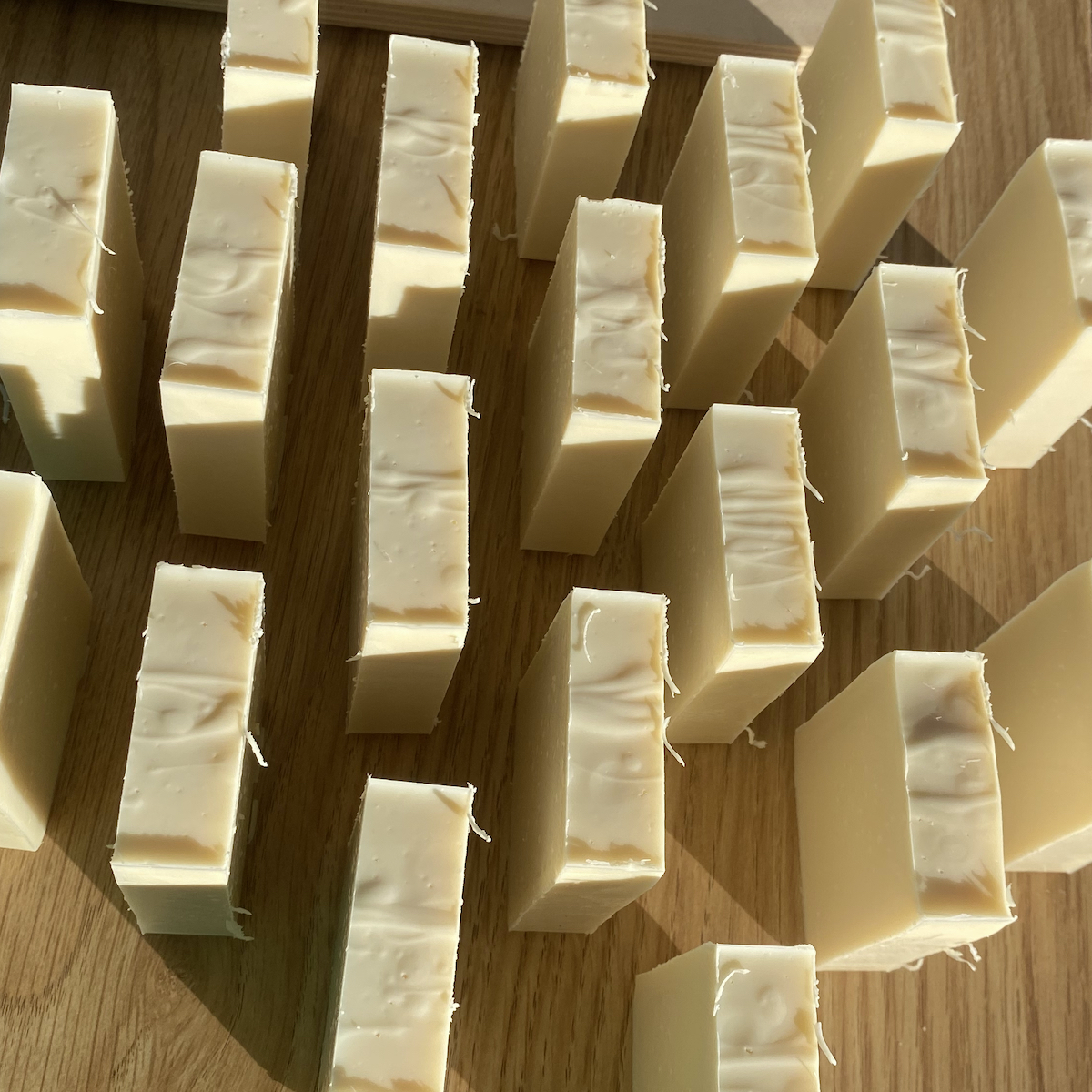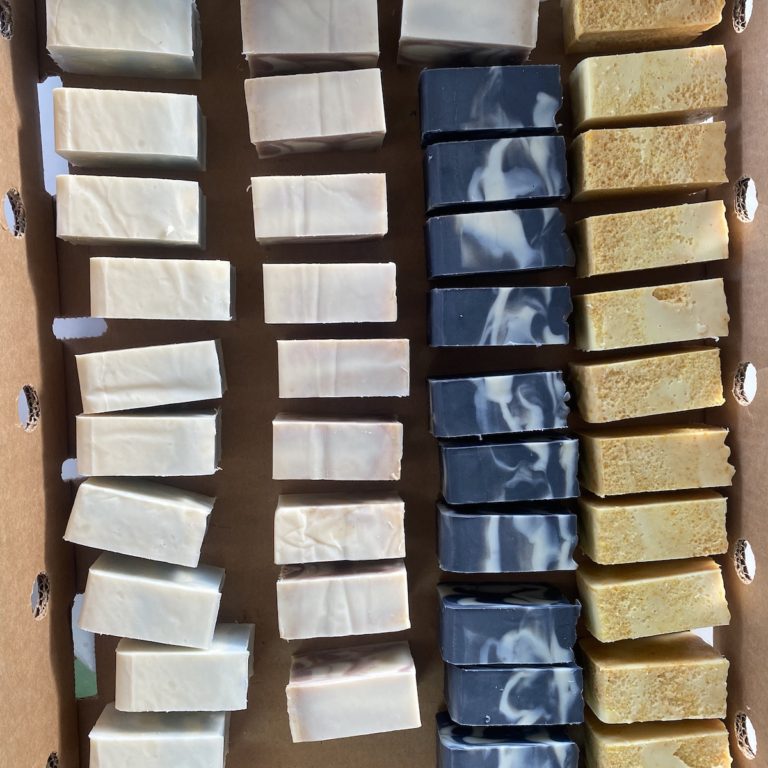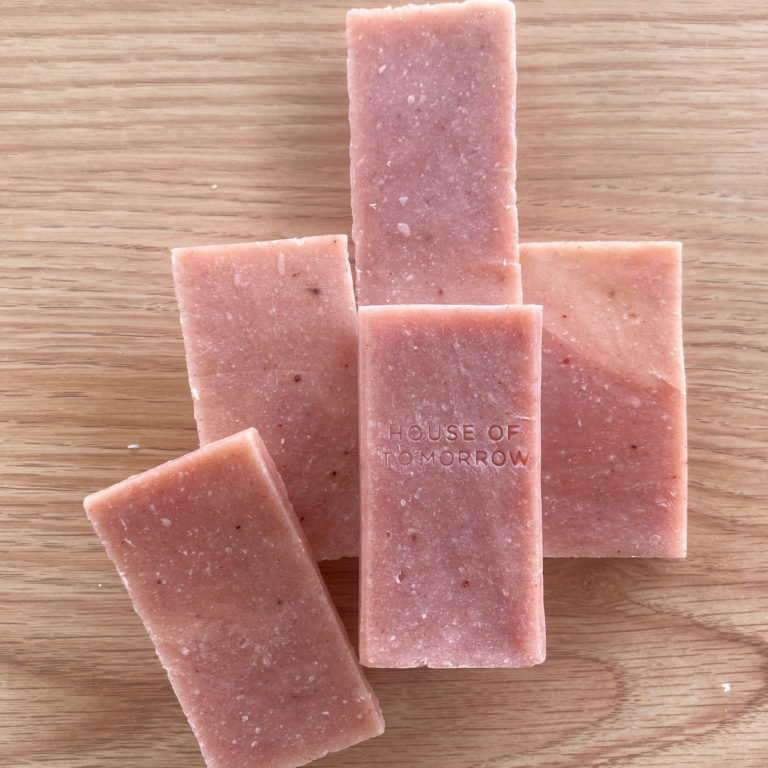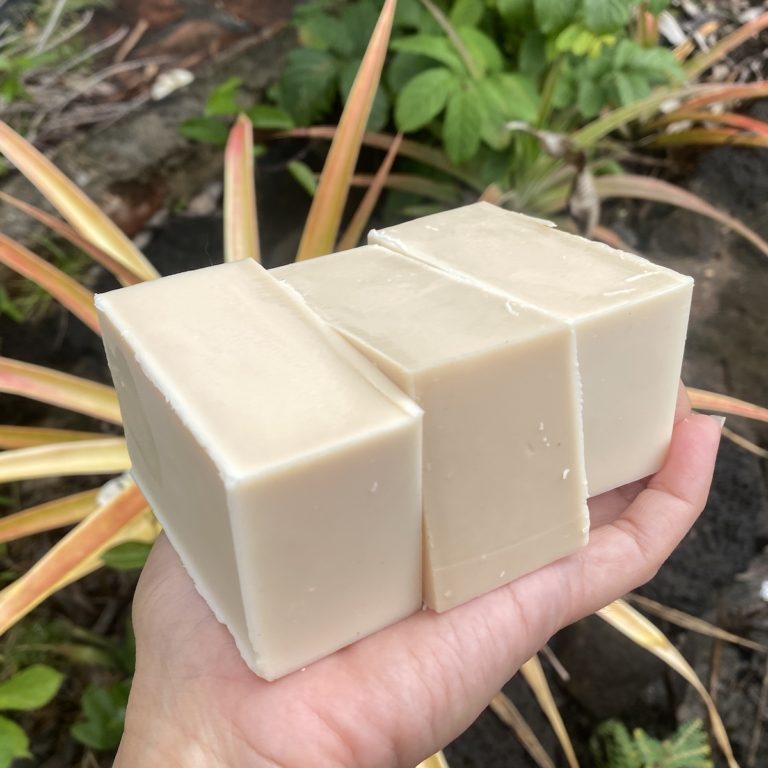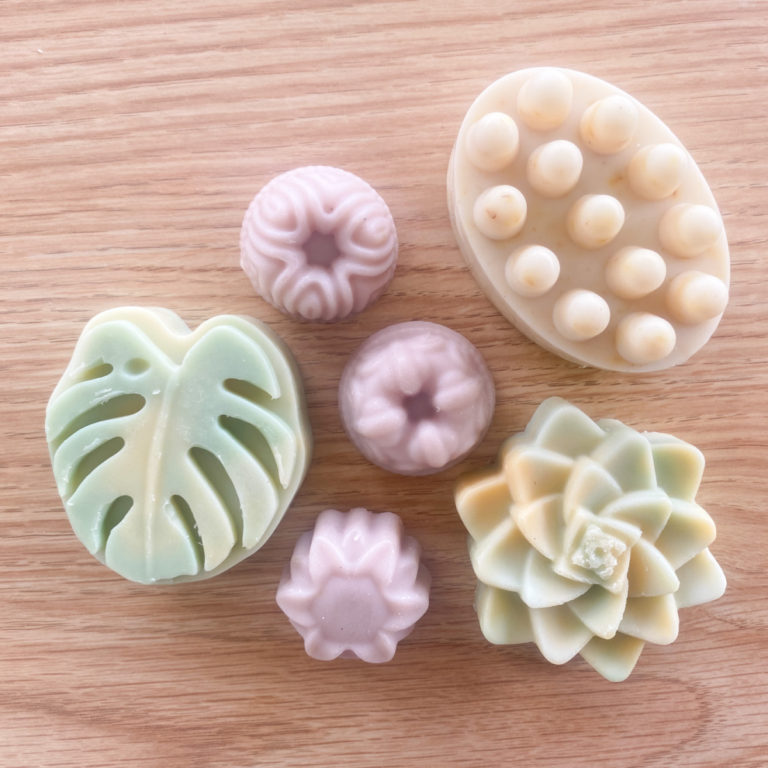How To Make Homemade Soap For Sensitive Skin
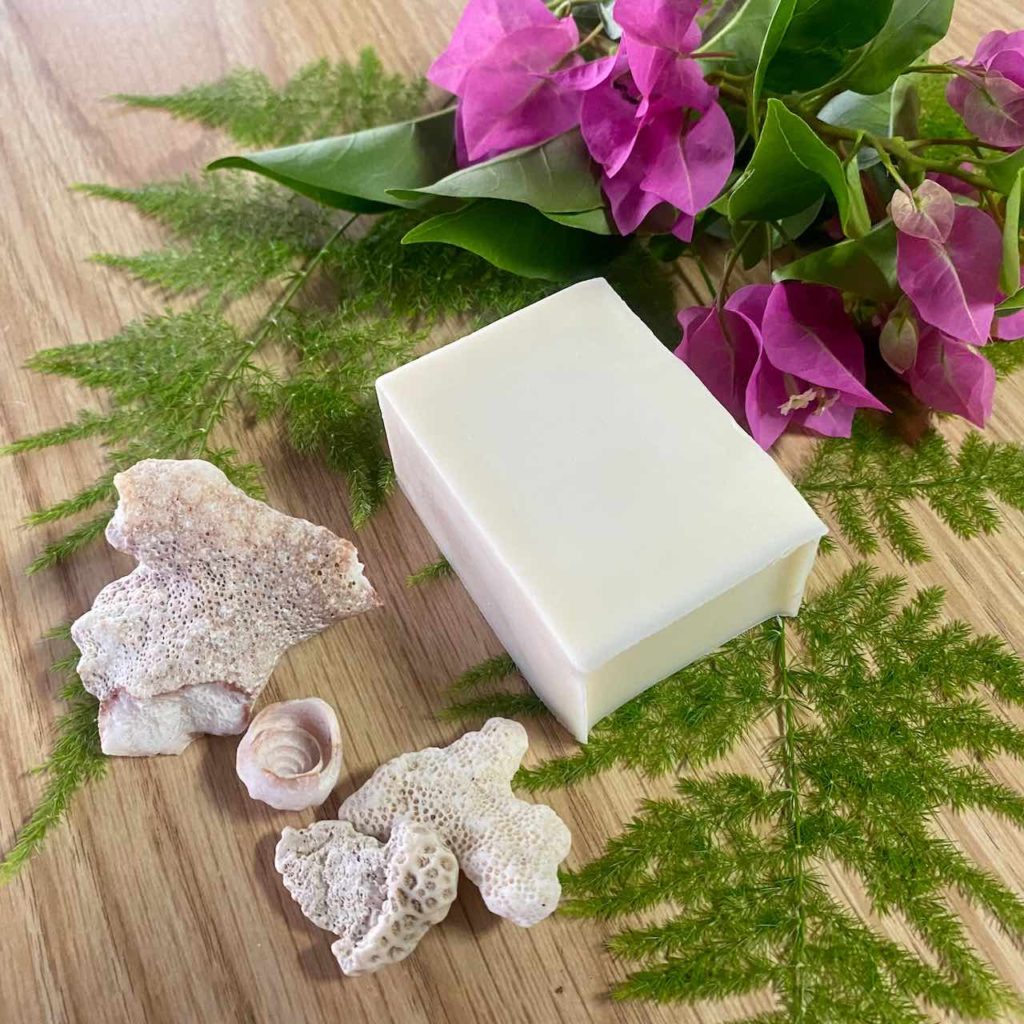
Organic handcrafted soaps made with non-toxic ingredients are a boon to people suffering from skin conditions and those whose skin reacts to artificial colors, fragrances, or preservatives. These soaps are available for purchase, but wouldn’t it be satisfying to create them yourself and put your personal stamp on them?
Make homemade soap suitable for sensitive skin by ditching fragrance oils which can contain hundreds of components under the single label “fragrance”, and artificial colorants, preservatives, and sulfates. Simply excluding these common offenders is a huge first step.
In addition, you can choose to limit your formulas to ingredients that are hypoallergenic (unlikely to cause an allergic reaction) and organic.
And if you’re leveling up, you can include common skin soothers (as long as you aren’t allergic to any of them), like calendula, chamomile, aloe vera, honey, lavender, etc.
If you’re on the lookout for simple, homemade soap recipes for sensitive skin, search no further. Try these out for sharing with friends and family, and possibly, business customers down the line. We have also included the essential ingredients that make soap sensitive skin-appropriate, so you know what’s safe to work with.
How To Deal With Sensitive Skin
Many people with sensitive skin are tired of false promises from bath and beauty product manufacturers claiming their brands will solve their skin problems. Most products don’t, regardless of the price. Many soap artisans got their start in creating all-natural soap out of their frustration from not finding a solution to their skin woes.
Unfortunately, the pharmaceutical and beauty industries have yet to develop a cure-all for skin conditions like excessive dryness/oiliness, eczema, and psoriasis. In the meantime, sufferers just have to manage these conditions, usually with medicinal preparations that may help temporarily but have side effects. After exposure to different substances, and trial and error, they learn what is good or bad for their skin. They then choose products accordingly.
Regular dryness is easier to take care of than the other more severe conditions. This is where an organic soap with fatty oil comes in. Follow this up with an effective all-natural moisturizer, and you’re good to go.
If you’re not sensitive to environmental or cosmetic conditions, you may choose to add natural colorants, fragrances, essential oils, and botanicals to your soaps to make them more interesting.
Glycerin for Sensitive Skin
The most common soaps for sensitive skin are the ones made of glycerin. According to Healthline, glycerin (aka glycerol) from plant-based oils also occurs naturally in fermented food, like bread and liquor.
In 1779, a Swedish chemist discovered glycerin by accident when he noticed a fat produced from an olive oil solution he heated. He perfected the method afterward. Thus was born the soap making process, which involves “cooking” plant oils, then letting these cool and harden into soap. Centuries later, we’re still using glycerin to make soap.
We have discussed how in a previous article. If you don’t want to make glycerin soap from scratch, just buy a readymade glycerin soap base.
Benefits of Glycerin Soap
The beauty of glycerin soap is that it is pure and all-natural, unlike many commercially produced soaps. It preserves your skin’s natural moisture to prevent excessive drying. Since it isn’t greasy, those with combination or oily skin can also use it.
Some studies have shown that glycerin’s anti-aging properties may help minimize (though not eradicate) blemishes and fine lines. As it doesn’t have chemicals, alcohol, fragrances, other skin irritants, and animal fat, it’s also vegan-friendly.
It is environmentally sound and non-toxic, but not necessarily hypoallergenic (not likely to cause allergies) if one were to consult the US Food and Drug Administration (FDA). As the FDA doesn’t regulate the use of this term, many soap manufacturers call their products hypoallergenic, even if this isn’t accurate.
Some hypoallergenic soaps contain trace amounts of fragrance, colorants, additives, or chemicals that may cause allergic reactions in sensitive-skinned people. Even though pure glycerin in commercial bath and beauty products won’t normally cause allergies, other ingredients might.
These extras won’t lessen the healing and moisturizing qualities of glycerin, but they may cause reactions or other side effects. If you have sensitive skin, do a patch test with your chosen beauty product before using it entirely to know your allergy risk.
Dermatologists recommend glycerin soap for people with these conditions:
- Rashes
- Wrinkles, crow’s feet, fine lines
- Psoriasis
- Hives
- Eczema (aka dermatitis)
- Rosacea
- Acne
- Extremely dry or oily skin
- Rubella, measles, smallpox, chickenpox
Essential Oils for Sensitive Skin
There is a vast array of essential oils, but only a few of these are safe for sensitive skin. You don’t have to add essential oils to your formula, but they can imbue many therapeutic properties to your soap. Besides, they make any soap smell heavenly.
The standard amount of essential oil for adding to regular homemade soap is 30 drops per batch, but you don’t have to strictly follow this rule. Note that sensitive skin is typically averse to strong fragrance. Let your skin and nose do the calculation. Combine your preferred essential oils to create soap unique to your (or your target market’s) personality and skin condition.
These essential oils are kind to sensitive skin:
- Chamomile—In tea form, it promotes restful sleep, thanks to its sedative properties. In oil form, it relieves pain, so it’s a common ingredient in massage oils.
- Geranium—It is antibacterial and anti-inflammatory, making it ideal for treating various types of acne. It smells like roses.
- Ylang-ylang—Despite its scientific name, Cananga odorata, it actually smells quite lovely and makes an excellent salve for troubled skin.
- Rose—Its essence is traditionally used to soothe inflamed skin, while its petals make exquisite decorative additions.
- Frankincense—Apart from relieving symptoms of upper respiratory tract infections, it is suitable for dry and mature skin.
- Lavender—In addition to being an effective cleanser for both oily and dry skin, it is a natural antihistamine. Its anti-inflammatory properties relieve most allergic reactions. Its phytochemicals ease stress and anxiety. Soapers usually combine it with frankincense.
- Tea tree oil—Its antiviral properties relieve redness, irritation, and inflammation. An excellent air purifier, it prevents allergens from exacerbating eczema flare-ups.
There are many other oils with numerous skin benefits. Check out the comprehensive list we published in a previous article for a mix-and-match gala of natural fragrance sources.
Melt-and-Pour Soap Bases
Apart from being an easy way to start making soap, melt-and-pour soap bases allow artisans to avoid handling lye. Some of these bases come in cubes or have lines telling you where to cut, but high-quality bars are easy to cut with an ordinary kitchen knife anyway, even without these demarcations.
To make soap for sensitive skin, pay attention to the components of your soap base. Vegan soapers avoid honey or goat’s milk. Some have issues with palm oil. Strict vegans can just look for specific labels marked “vegan formula” to save time sifting through long ingredient lists.
If you have dry skin, you need a creamier soap with moisturizers. Choose a shea butter soap base. An aloe vera soap base is more suitable for acne sufferers and people with oily skin.
Soap bases safe for sensitive skin:
- Glycerin
- Aloe vera
- Castile
- Honey
- Oatmeal
- Goat’s milk
- Shea butter
- Olive oil
Hot Process vs. Cold Process
The difference between these soap making processes lies in how long you have to wait before using the soap. You can use hot process soap right away, but the final product will look rustic and not as elegant as its cold process counterpart. You have to wait for at least two weeks before using cold process soap. Senior soapers recommend waiting a month.
Homemade Soap Recipes for Sensitive Skin
The Spruce Crafts has curated this database of basic soap making recipes. Fabulessly Frugal also has a collection of handcrafted soap recipes for novices. Choose the ones meant for sensitive skin.
Foaming Bentonite Clay Soap
One significant advantage of creating your own soap is that you can match the formula to your skin type and current condition. Dry skin needs a moisturizing milk base. Acne-prone skin needs the addition of clay to draw out germs, toxins, and impurities from the pores and pustules.
An exceptional example of a mild and soothing soap for problem skin is bentonite clay soap. Bentonite is an absorbent medicinal clay from volcanic ash. It has skin-healing properties. Try this recipe from One Good Thing.
Activated Charcoal and Tea Tree Soap for Acne-Prone Skin
Tea tree essence and activated charcoal are both powerful tools for battling acne. Tea tree oil is antifungal and antibacterial, while activated charcoal is astoundingly absorbent. Bellatory makes a superb soap for oily and acne-prone skin. Check it out here.
Aloe vera Soap
With its nourishing oil and aloe vera content, this cold process recipe from The Nerdy Farm Wife yields a gentle soap for ultra-sensitive skin.
The best way to make this soap is to extract aloe from a real plant to make sure you’re getting the genuine stuff. However, if you’re not inclined to deal with the mess that comes with manually harvesting plant essence, just buy readymade aloe gel from health food stores or aloe vera juice from Southeast Asian groceries. Those with ultra-sensitive skin may switch the coconut oil with babassu oil, edible oil from a Brazilian palm also added to cosmetic preparations.
Carrot, Turmeric, and Honey Soap
Cory O’Briant, the founder of Sunshine Soap and Candle Company, demonstrates how to make all-natural carrot, turmeric, and honey soap in this video:
Here are the benefits of honey:
- Dry skin and acne-afflicted skin both benefit from it.
- Honey in raw form is an effective exfoliant, but it’s not harsh.
- It is packed with antioxidants.
- As a humectant, it hydrates your skin.
- It minimizes irritation and evens skin tone.
Goat’s Milk, Oatmeal, and Almond Soap
Mom Makes Joy offers this recipe for oatmeal-infused soap. Oatmeal is traditionally used for soothing parched, itchy skin and is a popular ingredient in bath soaks for people with eczema. This recipe’s base is goat’s milk, which is both hypoallergenic and protein-rich. Most soap artisans (non-vegan, at least) consider goat’s milk soap as one of the mildest and purest cleansers one can craft by hand.
Since oatmeal doesn’t have a scent, add fragrance to your soap organically with sweet almonds and honey. Acne-prone skin and oily skin benefit from honey and oatmeal, but a better soap base for these skin types may be a clear one, like pure glycerin.
Here are the benefits of oatmeal:
- It soothes itchy skin.
- As it gently exfoliates dead skin, it benefits both flaky and acne-afflicted skin.
- It hydrates skin by forming a natural barrier against dryness with its protein and fat content.
- Its saponin content gently cleans the skin but won’t dry it out. Saponins are organic chemicals from plants that produce foam when mixed with water. They are said to be anti-microbial, anti-cancer, and anti-inflammatory. They also lessen cholesterol levels and boost the immune system.
Soap for Treating Eczema
Many people with eczema avoid traditional soaps because they aggravate the condition and dry the skin by stripping it of its natural oils. Organic soap, however, can help alleviate symptoms. This recipe from soap artisan Tanya Anderson, the founder of Lovely Greens, yields a scentless, moisturizing soap that relieves the dryness and itchiness typical of the disorder.
Its main ingredients are avocado oil and neem oil. The latter comes from the seeds and leaves of the neem tree native to the Indian subcontinent. It is used in Ayurvedic medicine specifically to treat eczema, psoriasis, and similar skin ailments, as well as resolve dental and even horticultural issues. Both oil types condition more than cleanse. Their natural compounds form a protective barrier on the skin.
This recipe calls for lye, which the beginner soap artisan might not want to mess with. So if you’re a novice, instead of the lye and these oils: coconut oil, shea butter, olive oil, and castor oil, simply buy a shea butter or olive oil melt-and-pour soap base. Melt this base, then add the neem and avocado oils to it.
A Mild Soap for Babies
Anne-Marie Faiola, the owner of Bramble Berry, author of the Soap Queen blog, and developer of Teach Soap demonstrates how to make this soap in this video:
The main ingredients in this gentle baby soap are colloidal oatmeal, bentonite clay, and an olive oil-and-chamomile infusion. The last one is a mixture of chamomile particles and pomace (pulpy residue), and oil from crushed olives. Faiola claims this cold process project is suitable for beginners. The ingredients and equipment she used are available from Bramble Berry.
As with the other recipes that call for handling lye, substitute the hard oil and lye combination with a melt-and-pour soap base to avoid dealing with this alkali (a chemical compound that neutralizes acids). The hard oils in this recipe are shea butter and castor oil, so the (alternative) soap base may be made from shea butter. Or, if you want to play safe, get a glycerin soap base, which is suitable for all skin types.
Bastille Soap With Shea Butter
This recipe from The Nerdy Farm Wife, though sourced from her Simple Natural Soapmaking book, is not as simple as it includes lye. However, if you’ve made several successful soap batches already and are comfortable working with lye, then you may be interested in trying your hand at it.
The recipe yields a soap with superb moisturizing and nourishing power due to its high shea butter and olive oil content. The added castor oil makes it an efficient lather-producer. You can substitute water with aloe vera juice or milk. You can substitute shea butter with tallow, lard, cocoa butter, or mango butter. Note that the first two are not vegan. Even with a substitution, you don’t have to change the quantity of lye.
Ingredients:
- Lye, 3.55 ounces
- Distilled water, milk, or aloe vera liquid, 8 ounces
- Shea butter, 4.5 ounces or 16%
- Castor oil, 2.5 ounces or 9%
- Olive oil, 21 ounces or 75%
Procedure:
- Before handling the lye, wear protective equipment. Goggles, face mask, gloves, long-sleeved shirt/blouse, and closed shoes. Carefully and slowly pour the lye into the distilled water (or alternative medium). Its contact with the water will produce some fumes. Just don’t breathe them in. This is why you need a face mask.
- Mix the lye and water well. This is your lye solution. Place it in a secure spot and let it cool to between 100 and 110°F (37.8 and 43.3°C).
- Melt the shea butter, castor oil, and olive oil and pour the lye solution (now cooled off) into the melted oils.
- Blend the liquids with a stick blender until the mixture reaches a consistency thick enough that if you trickle some soap batter onto it, it leaves marks on the surface before disappearing into the mix. (This stage is called “trace” in soap making terminology.)
- Pour the mixture into a silicone mold. Cover with a towel and let the batter sit for two days or until it gets easy to pop out of the mold.
- Cut the hardened soap into bars. “Cure” or expose these to open air for about a month before using. Senior soapers recommend a three-month curing time for soaps with high levels of olive oil, such as Bastille soaps. Like wine, they get better with age.
Calendula and German Chamomile Soap
This is another recipe from Lovely Greens. It combines the soothing essence of calendula flowers with the healing qualities of German chamomile essential oil in a sulfate-free soap. Calendula is a Mediterranean plant related to the marigold.
People with psoriasis and eczema will appreciate this soap because it cleanses gently and doesn’t over-dry the skin by replenishing moisture. You don’t have to handle lye with this recipe because it uses an organic premade soap base. Soap specifically for sensitive skin requires careful choice of ingredients.
Note that many ingredients, including essential oils, though organic, can irritate sensitive skin. So it’s critical to read up on ingredients, and how they react with each other before including them in formulas you plan to create or experiment with.
This recipe, which yields four bars and takes 30 minutes to create, uses an infusion of sweet almond oil and calendula flower petals. Add German chamomile essential oil for fragrance, and you have an amazing soap whose medicinal properties benefit people suffering from psoriasis or eczema. The only folks who should not use this soap are those allergic to ragwort, a plant from the daisy family with yellow flowers.
Sweet almond oil infused with calendula is easy to make. See the instructions below. If you can’t get a hold of sweet almond oil (or are not too fond of it), use any light oil instead, such as olive oil, grapeseed oil, or cold-pressed sunflower oil. Remember to use only high-quality calendula petals available from greenhouses, horticultural societies, herb merchants, and organic gardening supply stores.
The potent herb calendula contains medicinal properties that reduce swelling and accelerate the healing of sores, burns, and skin problems. Artisans of organic soaps use it to color their products yellow. They use the powdered kind for all-around color and dried flowers or petals to create designs with yellow spots or streaks.
Ingredients:
- Shea butter, one teaspoon
- Calendula-infused sweet almond oil, 1.5 teaspoon
- German chamomile essential oil, one teaspoon
- Transparent melt-and-pour soap without sulfate, one pound
Procedure:
- Infuse the sweet almond oil with calendula. Even though you can buy ready-made calendula-infused oil, why not make some yourself? Put some dried calendula petals in a mason jar. Fill it to the brim with your preferred oil. Cover it with its lid. Keep the jar wrapped in a paper bag on a warm window sill for two to three weeks, agitating it every couple of days.
- After the waiting period, use a strainer to separate the oil from the petals. Pour it into a separate jar. Throw the petals away or dry them and use them as potpourri. You now have calendula oil.
- Prepare the soap mixture by slicing the melt-and-pour soap base into chunks. Melt these with the shea butter by microwaving in 30-second intervals until entirely melted. Stir between intervals. You may also use the stove-top double boiling method. Place the pan containing the shea butter and soap base in a bigger pan filled halfway with water. Cover this contraption with a lid and heat it on a stove to prevent water from evaporating.
- Stir frequently until the soap and shea butter are fully melted. Take the pans off the stove. Pour in the calendula-infused oil and the chamomile essential oil, then blend well.
- Pour the batter into the mold. Fill the silicone mold with approximately a quarter-inch of soap batter. Scatter dried calendula flowers over the surface. Fill the rest of the mold with the remaining mixture. Lightly spray the surface with rubbing alcohol to prevent bubbles from forming. This move will also make your finished soap more polished and professional-looking.
- Let the batter cure. Let the soap batter cool to room temperature for about six hours to overnight or until it hardens and becomes easy to take out of the mold. Pop-out the soap from the mold. It is now ready to use and will last for up to one year.
Rice Bran Soap for Dry Skin
Soap artisan Melissa Will, who calls herself the “Empress of Dirt,” offers this soap recipe for dry skin with rice bran oil as the main ingredient. This thick, emollient oil comes from the topmost layer of rice. Its vitamin E and antioxidant contents replenish moisture to the skin and keep it from aging but won’t clog pores. You can use it on both hair and body.
Ingredients:
- Distilled water, 10 fluid ounces
- Lye crystals, 4 ounces
- Shea butter (from shea tree nuts), 2.6 ounces
- Cocoa butter, 3 ounces
- Coconut oil, 3 ounces
- Almond oil, 3 ounces
- Olive oil, 4.4 ounces
- Rice bran oil, 14 ounces
Procedure:
- Prepare the ingredients. Carefully add the lye crystals to distilled water and slowly mix. Set this lye solution aside in a safe area. Measure the oils and fats on a kitchen scale. Place them in a pot.
- Melt the solids. Melt the solid fats over low heat. After they are melted, simmer at about 110°F.
- Mix the ingredients. Once the fat-oil blend and the lye solution achieve 110°F, slowly pour the lye solution into the melted oil-fat blend. The liquid, previously clear, becomes opaque. Mix everything with a stick blender until it thickens and achieves a consistency similar to pudding. If you pour a little batter onto the surface and it remains on top, the mixture has entered the “medium trace” level.
- Pour the batter into the molds. Pour the mixture into the mold. Cover it with a towel to make it cool gradually. Rapid cooling may result in strangely colored portions, but these won’t affect the soap negatively.
- Let the mixture set. Allow the soap to set for 24 hours before removing it from the mold and cutting it into bars. The size of each bar is up to you. One 8”×4”x3” silicone loaf mold yields 10 to 20 bars, depending on how you slice them.
- Make your mark on your creation. You may want to stamp your soap with your favorite design or company logo. But wait another day before doing so to make sure the soap has the right consistency. Stamping is optional, of course.
Conclusion
Increased concerns over the potential adverse effects of ingredients in commercial bath and beauty products have spawned an entire industry of handcrafted, organically sourced soap creation. But even with artisanal soaps, professional soap creators join medical professionals in recommending that those meant for fragile or diseased skin should be mild and must not contain colorants, exfoliants, or fragrance.
Now that you know how to make soaps for sensitive skin, you can exercise judgment in choosing appropriate ingredients. The ideal formula cleanses thoroughly but gently, doesn’t dry the skin, and has healing properties that relieve common skin disorders.

